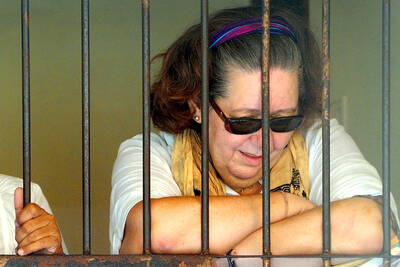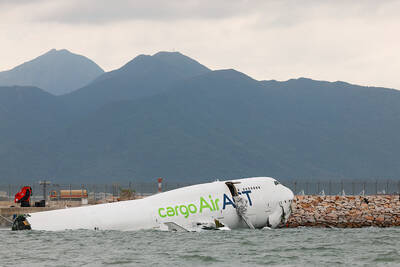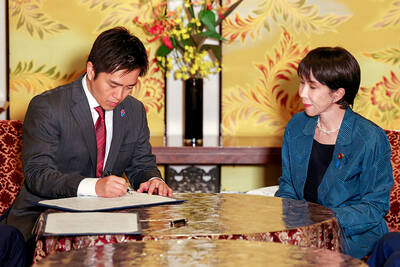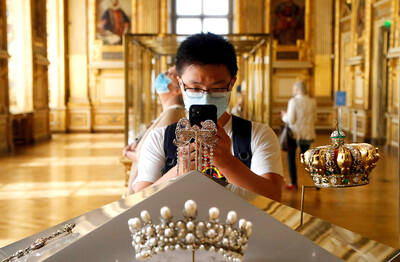The European robot lab Huygens found liquid methane on the Saturn satellite Titan, a chemical that seems to have shaped the moon's peculiar landscape and weather system, scientists said Friday in their first detailed assessment of the probe's mission.
"We've got a flammable world. It's quite extraordinary," said University of Honolulu researcher Toby Owen, referring to methane's combustibility with air on Earth.
"There is liquid on Titan. It has been raining not long ago, there is liquid methane," said Jean-Pierre Lebreton, director of the Huygens mission at the European Space Agency (ESA).
"There are truly remarkable processes at work on Titan's surface," he said.
US researcher Marty Tomasko of the University of Arizona said the data sent back by Huygens showed "many familiar earthlike processes: abrasion, erosion, precipitation."
"On the place where we landed, it had been raining not long ago, maybe two days ago," Tomasko said at a presentation to the press at ESA headquarters in Paris.
The rain -- not water but liquid methane, which is toxic to humans -- causes soil to run down from the hills and forms the rivulets and gullies that were visible in the raw images of Titan, shown to the world last week.
Huygens, a 319kg craft fitted with cameras, atmospheric sensors and gas analyzers, landed on Titan on Jan. 14, sending back data to a US mothership, Cassini.
Titan, the largest satellite of Saturn, was chosen as, intriguingly, it is the only moon in the solar system that has a substantial atmosphere.
Its thick mix of nitrogen and methane is suspected to be undergoing chemical reactions similar to those that unfolded on Earth billions of years ago. That process eventually provided the conditions for life on our planet.

Indonesia was to sign an agreement to repatriate two British nationals, including a grandmother languishing on death row for drug-related crimes, an Indonesian government source said yesterday. “The practical arrangement will be signed today. The transfer will be done immediately after the technical side of the transfer is agreed,” the source said, identifying Lindsay Sandiford and 35-year-old Shahab Shahabadi as the people being transferred. Sandiford, a grandmother, was sentenced to death on the island of Bali in 2013 after she was convicted of trafficking drugs. Customs officers found cocaine worth an estimated US$2.14 million hidden in a false bottom in Sandiford’s suitcase when

CAUSE UNKNOWN: Weather and runway conditions were suitable for flight operations at the time of the accident, and no distress signal was sent, authorities said A cargo aircraft skidded off the runway into the sea at Hong Kong International Airport early yesterday, killing two ground crew in a patrol car, in one of the worst accidents in the airport’s 27-year history. The incident occurred at about 3:50am, when the plane is suspected to have lost control upon landing, veering off the runway and crashing through a fence, the Airport Authority Hong Kong said. The jet hit a security patrol car on the perimeter road outside the runway zone, which then fell into the water, it said in a statement. The four crew members on the plane, which

Japan’s ruling Liberal Democratic Party (LDP) and its junior partner yesterday signed a coalition deal, paving the way for Sanae Takaichi to become the nation’s first female prime minister. The 11th-hour agreement with the Japan Innovation Party (JIP) came just a day before the lower house was due to vote on Takaichi’s appointment as the fifth prime minister in as many years. If she wins, she will take office the same day. “I’m very much looking forward to working with you on efforts to make Japan’s economy stronger, and to reshape Japan as a country that can be responsible for future generations,”

SEVEN-MINUTE HEIST: The masked thieves stole nine pieces of 19th-century jewelry, including a crown, which they dropped and damaged as they made their escape The hunt was on yesterday for the band of thieves who stole eight priceless royal pieces of jewelry from the Louvre Museum in the heart of Paris in broad daylight. Officials said a team of 60 investigators was working on the theory that the raid was planned and executed by an organized crime group. The heist reignited a row over a lack of security in France’s museums, with French Minister of Justice yesterday admitting to security flaws in protecting the Louvre. “What is certain is that we have failed, since people were able to park a furniture hoist in the middle of